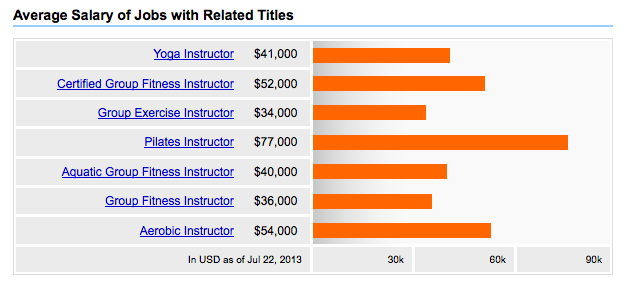Celebrity vs. normal teachers salaries: Should I quit my day job to teach yoga?
Photo: tumblr.com.
Let’s commence this series of discussions with an overview of the salaries and costs of the average yoga teacher…
If I want to earn a living teaching yoga, should I quit my day job?
For some, the answer may be yes. For others, perhaps not. Some yoga teachers are teaching yoga as an addition to their day job, while others have transitioned full-time to teaching, leaving their old nine-to-fives behind.
Is it possible to earn a solvent living teaching yoga?
As the popularity of yoga increases in the Western world, so do the opinions, stereotypes, expectations and conversations regarding yoga teachers and the amount of money they should or could make.
What do the facts and figures say?
The Bureau of Labor Statistics shares that in 2010, yoga teachers had an average salary of $35,920 per year, while the median income was $31,090 per year. The lowest paid 10% of yoga teachers made less than $17,070 per year. The lowest paid 25% of yoga teachers made less than $19,870 per year. The highest paid 25% of yoga teachers made more than $46,130 per year and the highest paid 10% of yoga teachers made more than $63,400 per year.
Said another way, according to these statistics, 75% of yoga teachers earn less $46,130 per year or 50% earn less than $31,090. This means that the few top yoga teachers (yoga celebrities) earn a lot more money compared to the rest.
Said in another way, there is an uneven distribution of income in the yoga teacher realm.
Indeed.com states that in 2013 the average salary for a yoga teacher in the US will be $41,000. Find the average yoga salary by U.S. state here.
How does this compare to the poverty threshold for a single person? According to The Center for Poverty Research, the current federal minimum wage in the U.S. is $7.25 per hour. If a minimum wage worker is employed full-time (forty hours per week for 52 weeks), he/she will earn $15,080 annually.
How does this compare to the new college graduate salary? According to Forbes, the average starting salary for 2013 grads earning bachelor’s degrees will have risen to $45,000 annually — up 5.3% from the average starting salary for the class of 2012.
What do you think about these figures? How do they fit with your perception of yoga teacher salaries? How do they compare to your own yoga teaching salary? Share your comments below.
Source: http://www.indeed.com/salary/Yoga-Instructor.html.
Yoga and the art of making money.
I have experienced yoga teachers charging almost nothing for their yoga classes. I have also heard of celebrity yoga teachers not showing up unless XX number of students sign-up for their weekend workshop. And I’ve heard of facilities paying fantastic amounts to yoga teachers, sometimes under the table, while others paying less than minimum wage (before taxes).
Here are some of the creative scenarios I’ve heard of and have encountered:
An employment contract: Probably the dream-scenario of most yoga teachers – a part-time or full-time contract with an annual salary and benefits. I believe this type of situation is rare, but most likely occurs within institutions (e.g. hospitals).
Minimum Wage Plus: Some studios may offer a minimum wage base plus a set amount for each student. In these situations the minimum wage typically constitutes for the first 3-4 students. The teacher will then earn an additional amount per student for any additional student up to a certain amount, capping the amount typically around the 10-15th student mark.
The rental agreement A – the official yoga studio: These studios allow you to use their space, props and facilities under the terms of a rental agreement versus employment of the yoga teacher. This situation bypasses any requirement to offer benefits or to pay a minimum hourly wage. The rent of the studio increases with the amount of students. Typically 40-60% of each head goes back to the yoga studio.
The rental agreement B – the open space: These locations rent out their space to the yoga teacher — props not always included. The teachers pay the same rent no matter the amount of students. The location is not responsible in any way for the number of students or the payment of the students. This responsibility lies solely with the teacher.
The per class agreement: The studio or a facility offers the yoga teacher a fixed amount per class no matter the number of students. I have heard this range to typically be double minimum wage or slightly above it.
Under the table and dreaming: Some teachers offer classes in their homes or the homes of others and ask students to pay in cash. Teachers may also offer private classes or one-on-one classes where the price is often doubled, tripled or even quadrupled. In some scenarios teachers may find a location to teach rental-free such as a church, the rec-room of an apartment complex, etc.
The weekend workshop: Teachers may get invited or offer to teach a weekend workshop at a studio or open-space. The yoga teacher will often pay in full or split the rental fees with a local designated organizer (if there is one) in addition to splitting the participant income with the organizer for their promotional efforts. Teachers might agree to a minimum amount of students with the studio and/or organizer.
I am sure there are plenty more creative scenarios to be shared as yoga is still seemingly new in the West, but as we can see, traditional employment contracts are not common. The standard formula, if there will ever be one, for establishing a yoga income is still being worked out.
Perhaps the hodge podge of payment plans exist because there is no real yoga union (would you like one?).
There are also other ways a yoga teacher can accumulate income, especially if one is popular enough (e.g. the celebrity yoga teacher) — sponsorships, accessories, books and hosting teacher training are to name a few, but these often come after years and years of teaching, a bit of luck, and the establishment of a major following.
So perhaps the ongoing discussion on how to compassionately commodify this non-traditional, spiritual and philosophical working profession is a natural part of the evolution of yoga… unless we all find a way to live earning less, find a replacement for money and/or stop using it completely.
What are the scenarios you’ve encountered? Share your comments below.
Source: www.thefiscaltimes.com.
Some things you may not have considered about your yoga teacher (or if wanting to become a yoga teacher):
As most self-employed business owners, free-lance artists, craftsman and entrepreneurs learn quite quickly, it takes time and money to prepare, maintain and get yourself out there. Here are some key considerations to keep in mind about the life of a yoga teacher:
- The education: For the 200-hour yoga teacher training certification, the average cost can range from $5,000 up to $20,000. This price typically does not include travel or accommodation. Ongoing training for teachers can range anywhere up from $150 for a couple of hours to again, thousands for another 100-2oo hours of training. Additional training is highly recommended to grow and maintain skills, knowledge and experience.
- Time & travel: A typical yoga teacher will teach at a couple to several venues per week. Transportation costs, parking and fuel can typically be a write-off, sure, but it still has to be paid up-front. Even if by bicycle, the time it takes to get there has to be taken into account and can limit your availability to take on more
- Insurances: Insurances such as liability, if needed, can add up to $250 per year.
- Website & Promotions: Be prepared to pay for and possibly set up your own website — a crucial channel to get you out there. In most instances a teacher will be responsible for advertising and promoting him/herself via business cards, flyers and word-of-mouth. All of this takes time, energy and a bit of money.
Another key element to consider is fluctuation. If you are a teacher being paid per student, you are more at risk for income fluctuation. Seasonality, sickness, financial crises and other personal situations can severely alter the number of students per class. In other words, there are no guarantees.
If you are also looking for job security, a 401K and pension plan, perhaps keeping your day job is a good idea — and, despite years of experience, don’t expect a pay raise.
If you really want to be a yoga teacher, getting a second job or keeping your existing 9-5 may be a great idea for a little while. The last thing you want to do is put yourself in dire straights because of little to no earnings, especially if you can’t pull it off. Like nearly everything in this life, earning a solvent salary from yoga teaching takes time, practice and a whole lot of patience. A secondary income may offer you piece of mind and the time to further develop who you are as a yoga teacher. And, don’t forget to use the skills you already have.
Stay tuned for: How to make business ethical in yoga — is that student just another 25 bucks?
*****
{Live Your Dream & Make An Unexpected Living.}




